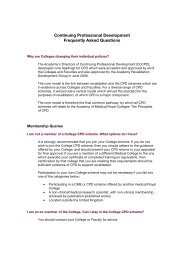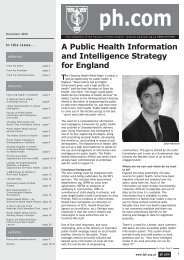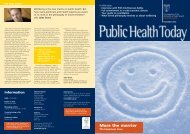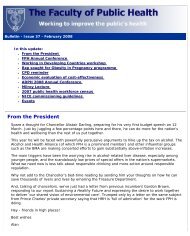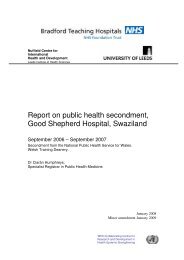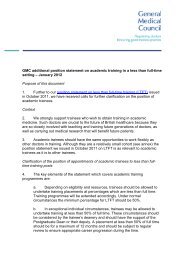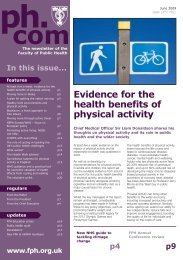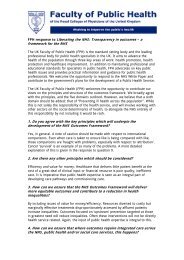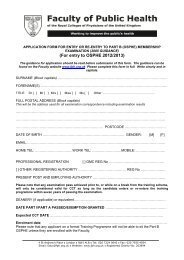A Chronology of State Medicine, Public Health, Welfare and Related ...
A Chronology of State Medicine, Public Health, Welfare and Related ...
A Chronology of State Medicine, Public Health, Welfare and Related ...
Create successful ePaper yourself
Turn your PDF publications into a flip-book with our unique Google optimized e-Paper software.
1970<br />
1970 Office <strong>of</strong> Population Censuses <strong>and</strong> Surveys (OPCS) established by a merger <strong>of</strong> the<br />
General Register Office <strong>and</strong> the Government Social Survey Department. See 1996.<br />
Local Authority Social Services Act (c.42) created the administrative framework for<br />
implementing most <strong>of</strong> the recommendations <strong>of</strong> the Seebohm Committee (1968); led to the<br />
setting up <strong>of</strong> social services departments within local authorities by bringing together staff<br />
from the childrens, welfare <strong>and</strong> health departments in 1971.<br />
Chronically Sick <strong>and</strong> Disabled Persons Act (c.44) extended the powers <strong>and</strong> duties <strong>of</strong><br />
local authorities to help disabled people; required authorities to know the number <strong>of</strong> persons<br />
in their area needing help; to ensure that available services were well publicised; empowered<br />
authorities to provide help with activities <strong>of</strong> daily living, leisure activities, holidays,<br />
travelling, telephones <strong>and</strong> house adaptations; required new buildings <strong>and</strong> public toilets to be<br />
accessible to disabled people but only "in so far as it is in the circumstances both practicable<br />
<strong>and</strong> reasonable"; made it m<strong>and</strong>atory for certain committees to have one or more disabled<br />
people as members; required younger chronically disabled patients to be cared for separately<br />
from the care <strong>of</strong> elderly disabled people; introduced special badges for motor vehicles driven<br />
or used by disabled people; <strong>and</strong> made provisions for special educational facilities. See 1972<br />
<strong>and</strong> 1981.<br />
National Insurance (Old Persons' <strong>and</strong> Widows' Pensions <strong>and</strong> Attendance Allowance)<br />
Act (c.51) extended the eligibility for widows' pensions; introduced non-contributary<br />
pensions, as <strong>of</strong> right, to all people aged 80 years or more; <strong>and</strong> an "Attendance Allowance" for<br />
a disabled person needing frequent or continuous attention as determined by an Attendance<br />
Allowance Board. Payments started in 1971. See 1971.<br />
Family Income Supplements Act (c.55) provided for a new benefit, administered by the<br />
Supplementary Benefits Commission, for families with small incomes. Such families were<br />
exempted from health service charges <strong>and</strong> the children were eligible for free school meals.<br />
See 1975.<br />
Education (H<strong>and</strong>icapped Children) Act (c.52) discontinued the classification <strong>of</strong><br />
h<strong>and</strong>icapped children for educational purposes <strong>and</strong> transferred the education <strong>of</strong> h<strong>and</strong>icapped<br />
children who were previously the responsibility <strong>of</strong> the health departments to the education<br />
departments. See 1978.<br />
Equal Pay Act (c.41) disallowed discrimination between men <strong>and</strong> women in terms <strong>and</strong><br />
conditions <strong>of</strong> pay; <strong>and</strong> obliged firms to pay men <strong>and</strong> women who are doing the same job the<br />
same wage by the end <strong>of</strong> 1975.<br />
Matrimonial Proceedings <strong>and</strong> Property Act (c.45) established that a wife's work, as<br />
either a housewife or wage earner, should be considered as an equal contribution towards the<br />
creation <strong>of</strong> the family home. See 1973.<br />
Radiological Protection Act (c.46) set up the National Radiological Protection Board<br />
which became responsible for all radiation protection functions. See 1976.<br />
The St<strong>and</strong>ing Royal Commission on Environmental Pollution appointed to "advise on<br />
matters, both national <strong>and</strong> international, concerning the pollution <strong>of</strong> the environment; on the<br />
adequacy <strong>of</strong> research in this field; <strong>and</strong> <strong>of</strong> future possibilities <strong>of</strong> danger to the environment".<br />
See 1974.<br />
"The Protection <strong>of</strong> the Environment. The Fight against Pollution", a White Paper,<br />
Cmnd. 4373, published. See 1974.<br />
The Twelfth Report <strong>of</strong> the Review Body on Doctors' <strong>and</strong> Dentists' Remuneration,<br />
Cmnd. 4352, published. Later the members <strong>of</strong> the Board resigned after the Government had<br />
indicated that it would not accept its proposals. See 1971.



